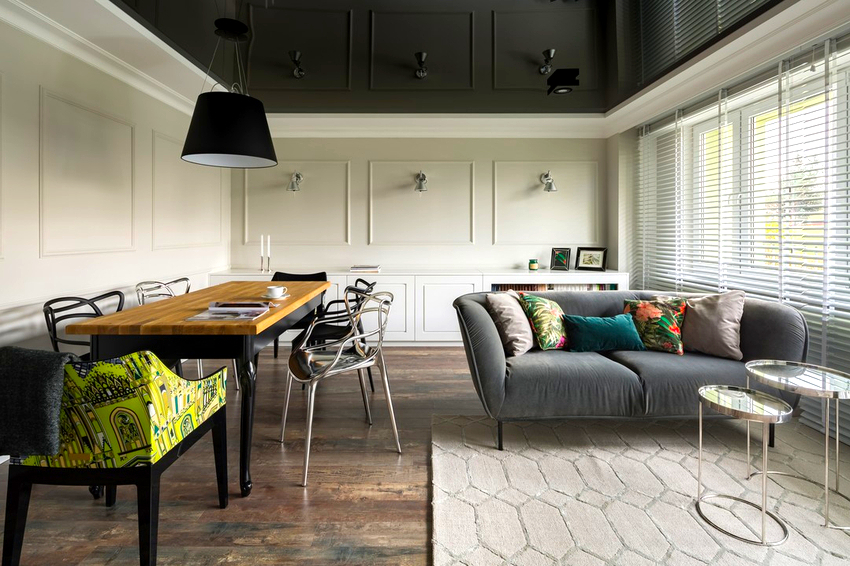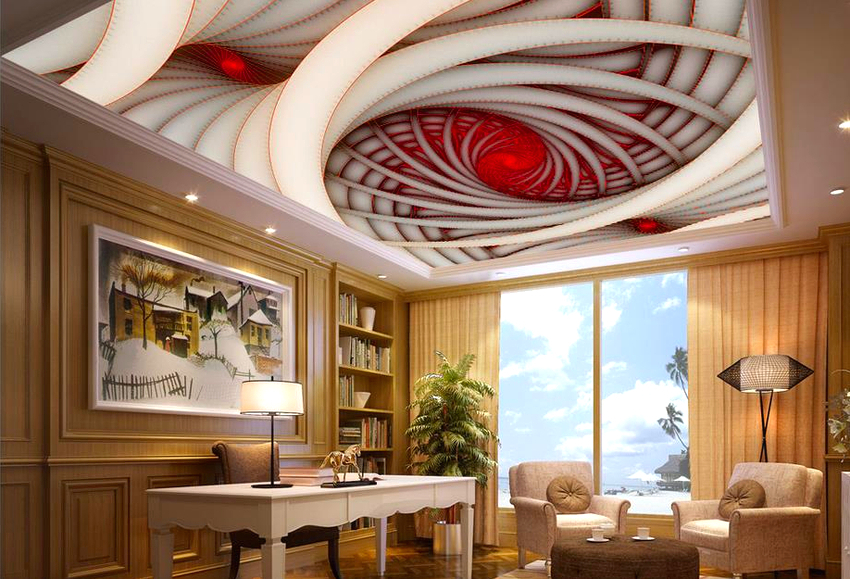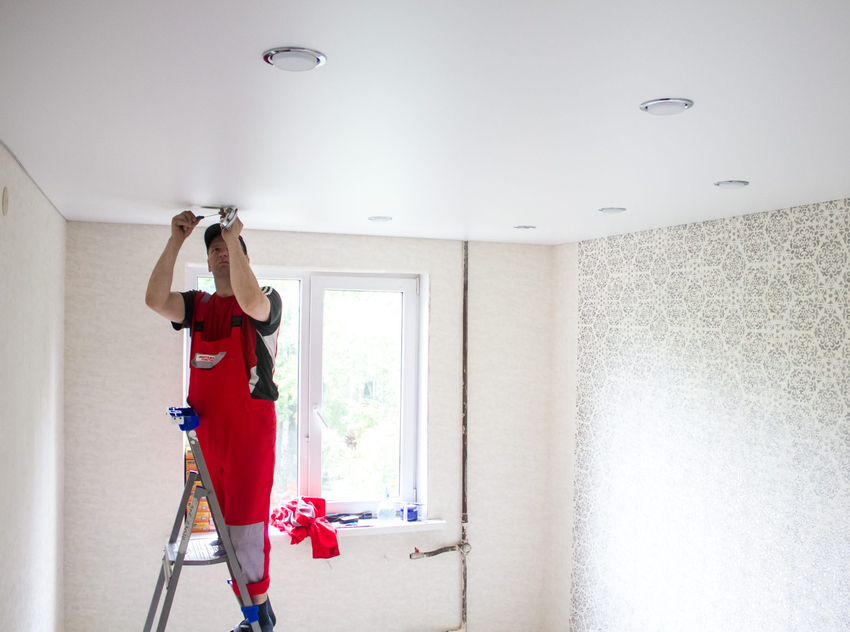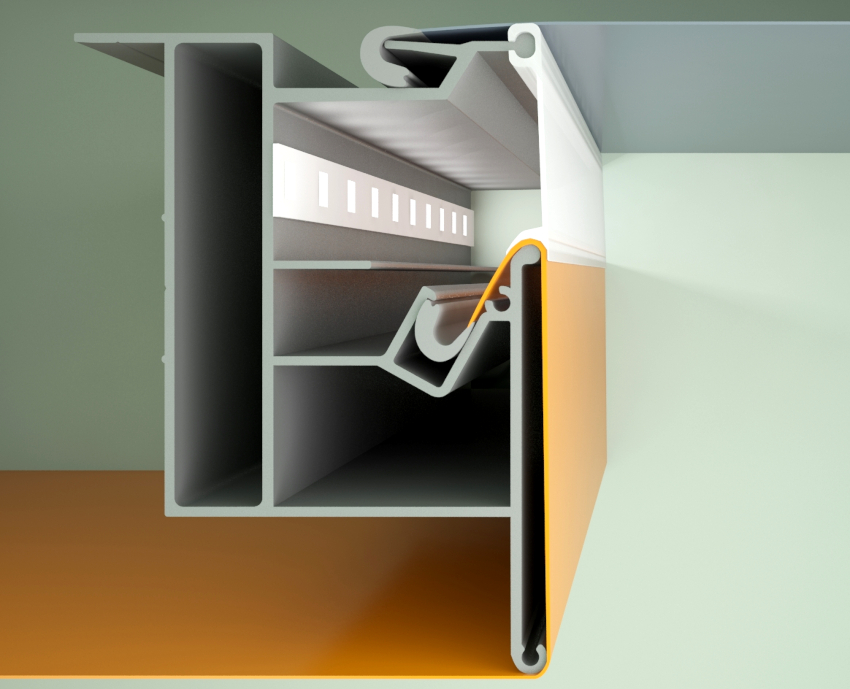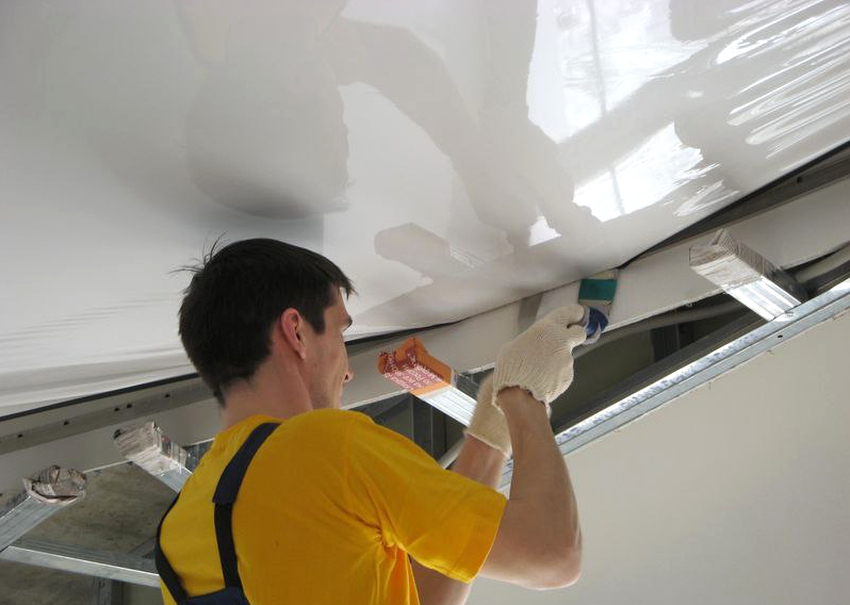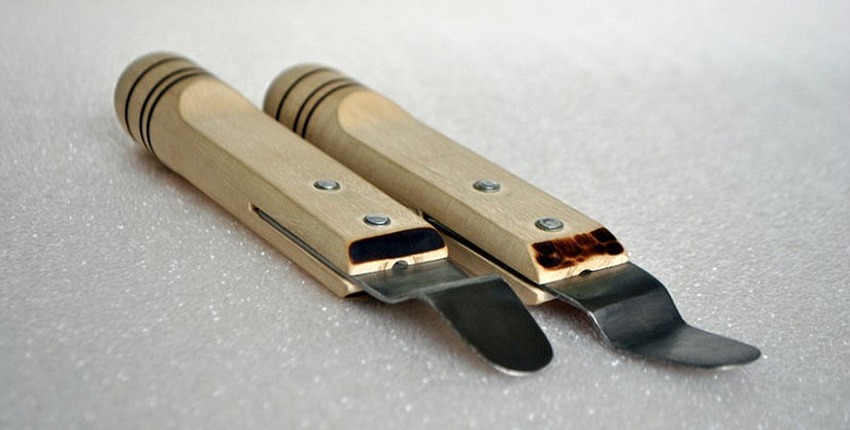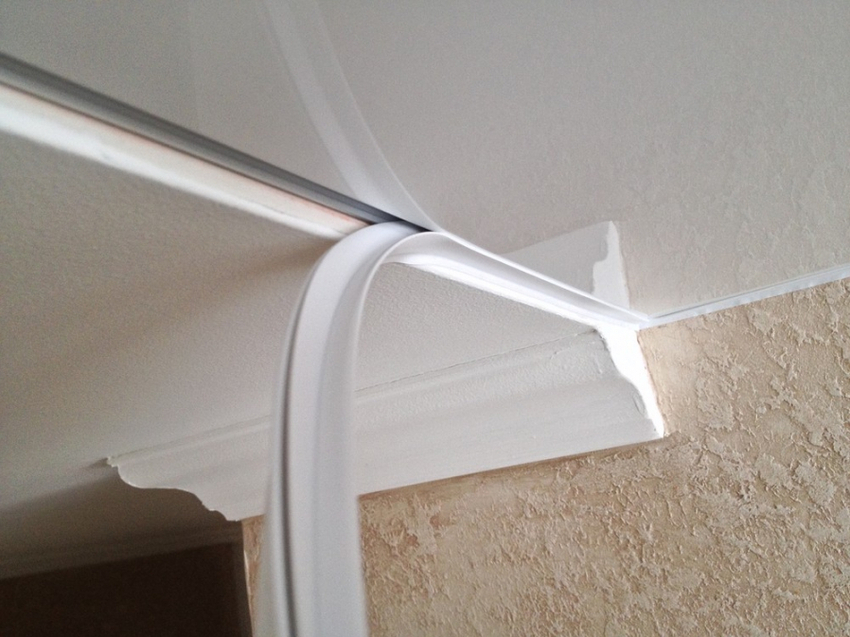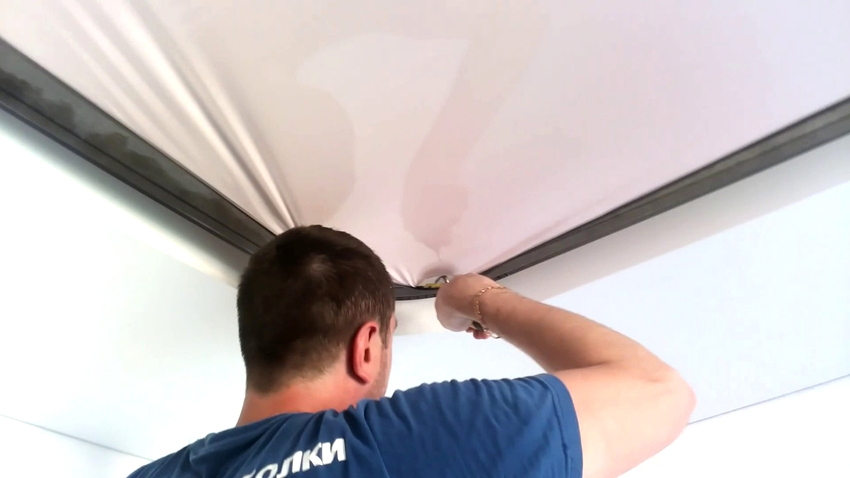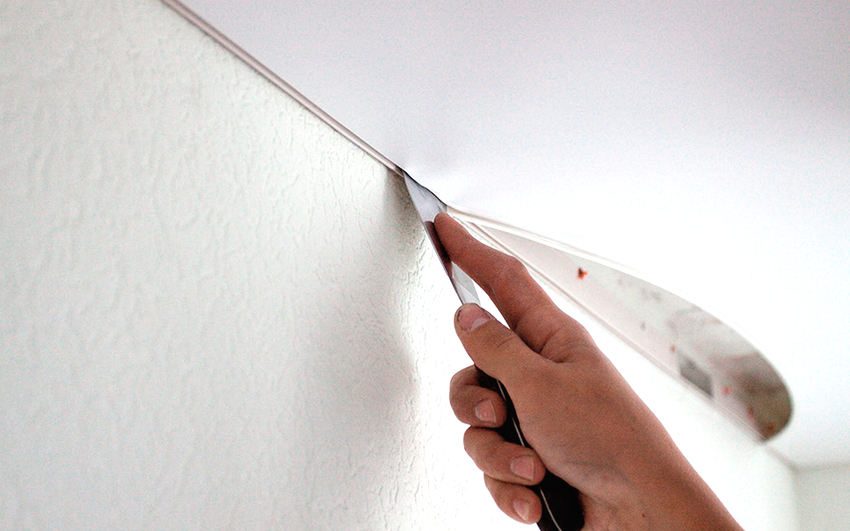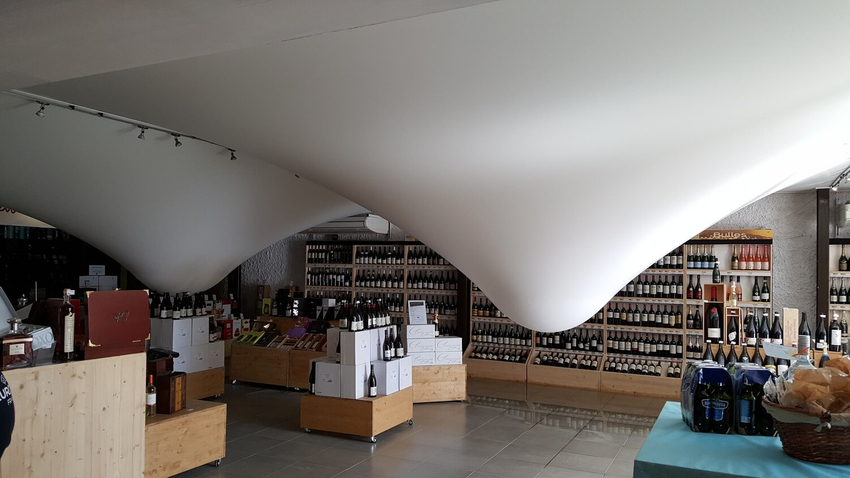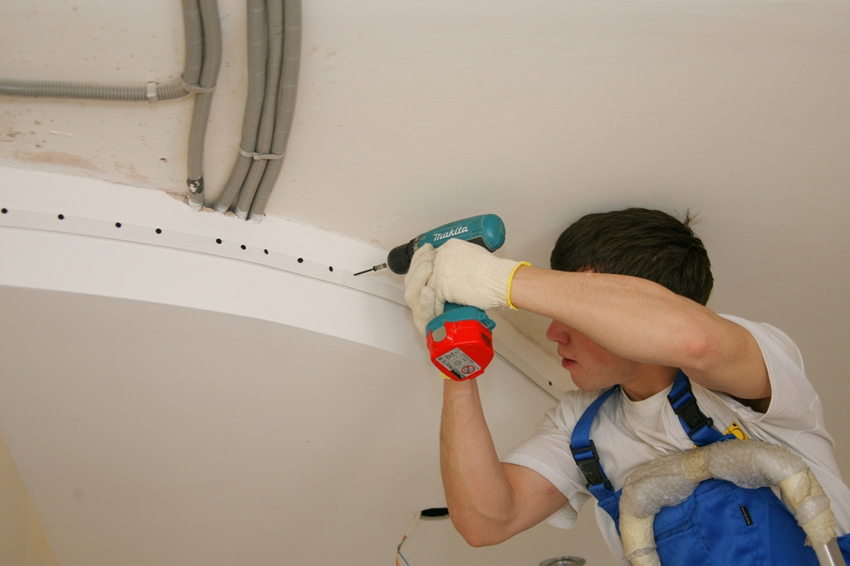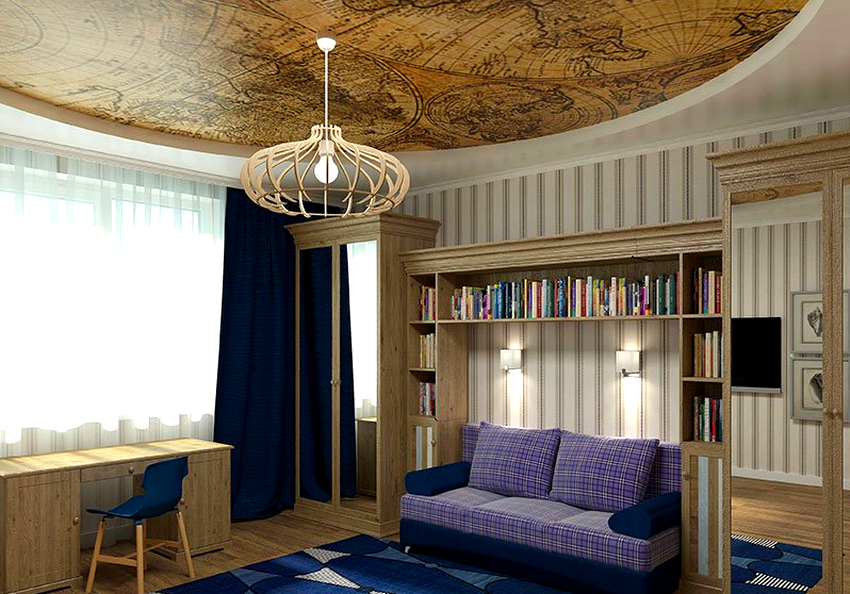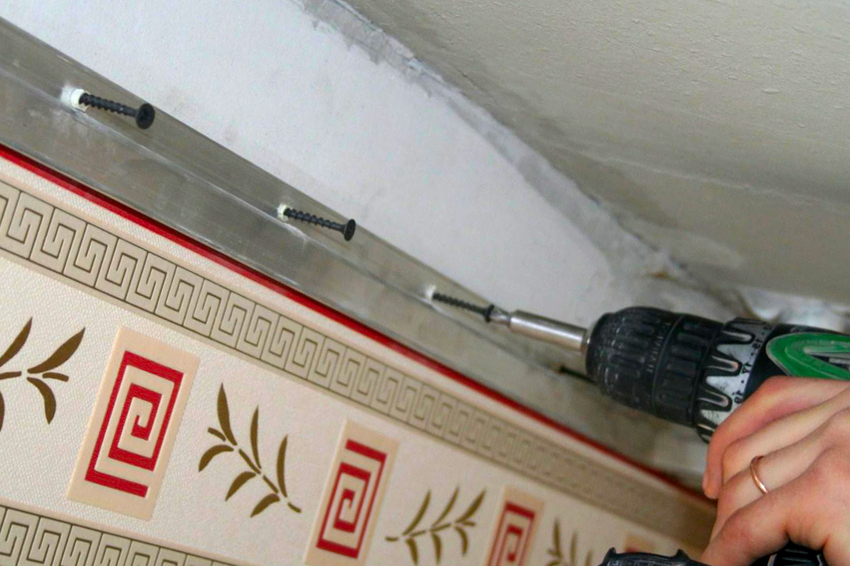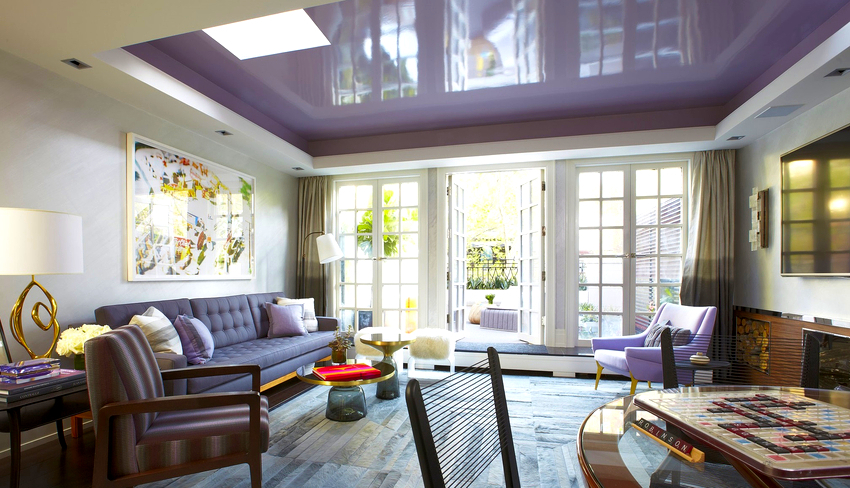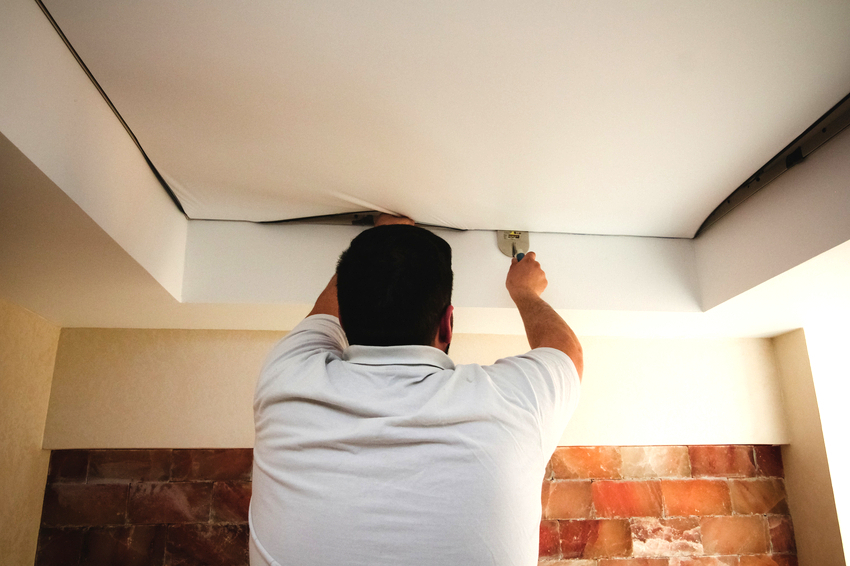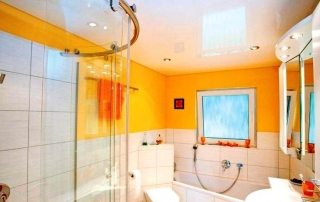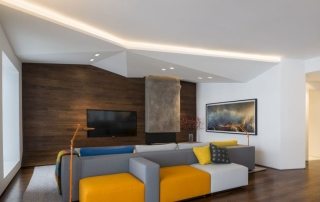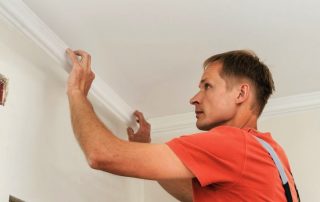If you want to do well, do it yourself. And if you decide so, confidence alone will not be enough - you need knowledge. Knowledge of the quality of materials, technology features, possible problems and errors. You will need skills that will certainly appear in the course of work. And at the initial stage, they can be spied on from others and taken into service. How to mount stretch ceilings with your own hands - in the materials of this article.
Content
- 1 Stretch ceilings in an apartment, a house: a convincing "yes"
- 2 Standard technology for installing stretch ceilings
- 3 Is it possible to do the installation of a stretch ceiling yourself
- 4 Stretch ceiling installation methods: advantages and disadvantages
- 5 How to make stretch ceilings on plaster walls
- 6 How to remove a stretch ceiling with your own hands: a sequence of actions
- 7 How to install a stretch ceiling after repair
- 8 How to stretch a stretch ceiling after flooding
- 9 Installing a chandelier on a stretch ceiling with your own hands
- 10 Features of installing a stretch ceiling in a room with a small height
- 11 Diy two-level stretch ceiling
- 12 DIY fabric ceilings: installation technology, video tutorials
- 13 DIY stretch ceiling: step by step instructions
- 14 How much is the installation of a stretch ceiling, the price of the canvas
- 15 DIY stretch ceilings: material and interior
- 16 Do-it-yourself stretch ceiling: reviews, opinions
Stretch ceilings in an apartment, a house: a convincing "yes"
Everything new is well forgotten old. The walls of the dwellings, including the ceilings, were covered with fabric back in the era of the pharaohs. The great popularity of the installation of stretch ceilings in rooms today is due to the combination of the following design qualities:
- a high level of aesthetics;
- availability and speed of installation;
- the ability to hide the flaws of the main ceiling under the canvas;
- a variety of coatings.
Among the products offered on the market, it is easy to choose an option for every taste, corresponding to a certain style of design. With the help of a stretch canvas, you can make an accent by decorating a faceless and inexpressive interior.
With regard to physical costs, then with any other way to make the ceiling perfectly even, they will need much more. Putting involves preparing the mixture using additional tools already at this stage. This is followed by application, leveling, waiting for drying, sanding ... After working with the putty, a serious cleaning of the room will be required.
The suspended ceiling also does not withstand the competition.Make it like a stretch, ideally smoothly and quickly, such a ceiling will not work. The need to install each fragment, fixing it to the concrete ceiling (most often it is just that), will require a significant amount of time.
According to the features of performance and the specifics of installation, tension structures today occupy a leading position.
Standard technology for installing stretch ceilings
The technology for installing stretch ceilings is based on fixing the material to the upper part of the walls or to the ceiling itself along the entire perimeter of the room. That is, a frame is needed for the canvas. It is made of profiles with a specific configuration of the interior. It is very important that the planes to which the baguettes will be fixed do not have protrusions, depressions, etc. Therefore, defects on the walls are eliminated before mounting the structure. This is done both with the help of leveling mixtures and using drywall.
The baguettes are fastened at a certain pitch, which is 10-20 cm, depending on the density of the canvas, which determines its weight. Then the material is inserted directly into the profiles. There can be several ways of fixing.
When using almost any technology, the stretch ceiling, that is, the canvas, cannot adjoin the wall tightly. Therefore, a gap forms between the surface and the film. It does not affect the functioning of the structure, but for aesthetic purposes it is covered with a strip of soft colorless material.
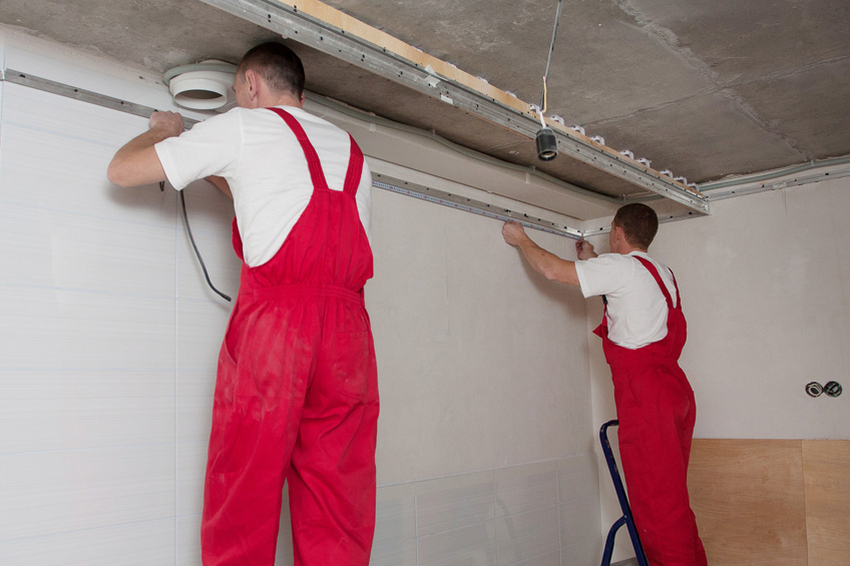
The standard technology for installing stretch ceilings implies the presence of a frame made of profiles
Important! When using different canvases and technologies, any stretch ceiling installation must be started with preliminary measurements. This should be done by a person who will directly perform the work.
The importance of preparing the base surface for stretch ceilings
The warranty for stretch ceilings is 10-25 years, depending on the material used. But it will correspond to the declared deadline only if all preparatory work was completed before the installation began, in particular, the base surface was brought into proper condition. The canvas will hide irregularities, but it is categorically not recommended to ignore the cracks in the main ceiling.
Such defects are characterized by the continuation of the destructive process. Over time, the crack will increase, pieces of plaster or the base of the ceiling will fall off from the edges and collect on the inner surface of the film. To avoid these problems, before installing stretch ceilings, the ceiling must be strengthened by sealing up all cracks and cracks.
Moreover, if defects were formed due to high humidity, then it is worth using moisture-resistant materials. It is better to repair concrete floors with cement mortars. If it is impossible to eliminate defects locally, it is advisable to hem the ceiling with light sheet materials.
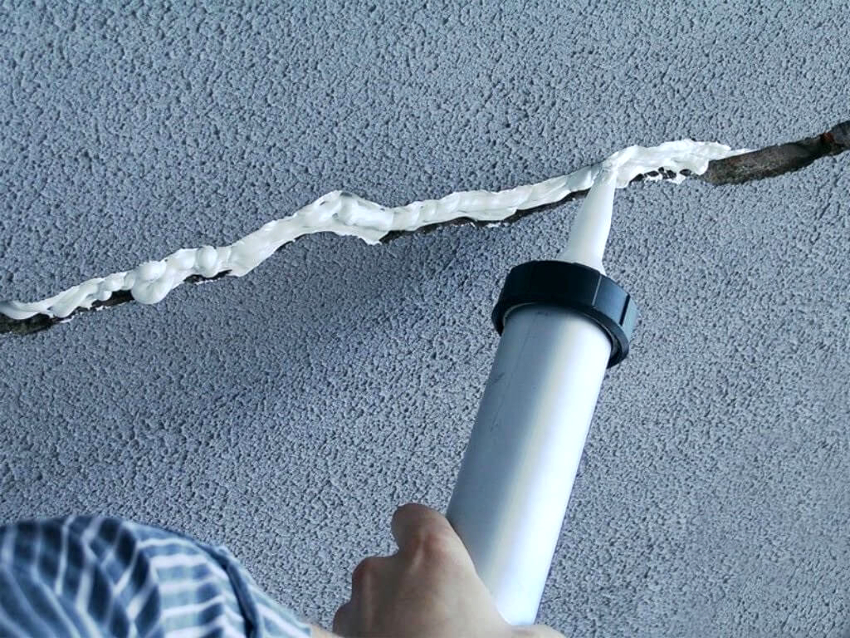
Before installing the tension web, it is necessary to strengthen and seal all the cracks and cracks in the ceiling
In conditions when the slabs of concrete floors are at different levels and form a threshold on the ceiling, it is not recommended to putty or cover up the place of their joint with any type of solution. First, it is ineffective; secondly, the plaster of such seams, due to vibrations (they are not felt, but they certainly take place), will crumble.
Is it possible to do the installation of a stretch ceiling yourself
Many people prefer to make repairs in a house or apartment on their own. The reasons can be different - from the need or desire to save money to confusion due to the inability to find qualified professionals who should be trusted. Is it possible to do the installation of a stretch ceiling with your own hands? Everyone should find the answer to this question for himself.
Only desire is not enough.There are several prerequisites:
- knowledge of installation technology;
- availability of tools, devices and the ability to use them;
- skills in making correct measurements;
- diligence, consistency and patience as character traits.
The installation process will give the desired result only if the necessary actions are carefully and gradually carried out. In order to stretch ceilings, as practice shows, even physical efforts should be distributed in a certain way and focused in the right direction.
Professionals assemble structures in 2.5-4 hours. Self-installation will take an additional 1.5-2 hours, since the lack of skills affects. Most of the time is usually spent on marking and fixing the profile.
Useful advice! Before deciding on the independent installation of a stretch ceiling, it is worth trying to get a piece of canvas on a fragment of a baguette in order to understand the features of the fixing technique. It is this part of the work that most often causes difficulties.
Stretch ceiling installation methods: advantages and disadvantages
There are three main ways of installing stretch ceilings, for which different types of fasteners are produced. The latter are based on profiles (baguettes), their internal structure provides fixation of the canvas. When installing stretch ceilings with your own hands, the following technologies are used:
- Harpoon. The main attachment element received this name due to the similarity with a hunting weapon. Baguettes are fixed to the walls. Harpoons are welded along the perimeter of the canvas, which attach the film to the baguette and contribute to its tension.
- Wedge (or glazing bead). The profile for this type of installation is U-shaped. With the help of plastic (sometimes wooden) glazing beads, the canvas is clamped in the profile.
- Clip-on. A plastic profile is used. In its inner part there are elements that act on the principle of clothespins - clips: the inserted canvas snaps into place.
Before installing a stretch ceiling, you should decide on the type of fastening. The choice of the canvas largely depends on it. The harpoon system is the most common, but it can only be used when installing PVC films. Clip option - for fabric ceilings. The wedge method is used for two types of canvases, but professional skills are required in order to stretch and fix the film web well without damage. It is easier to work with a fabric material in this regard, but it is not easy to provide the required tension.
The wedge method allows you to install a stretch ceiling with a minimum deviation from the base base - 1.5-2 cm is enough. The clip fastening does not leave a gap between the ceiling and the wall, so no spacers are used. But for the harpoon system, decorative sealing of the gap is mandatory, otherwise aesthetics are lost.
Profiles used in the installation of stretch ceilings
As mentioned above, the main fastening of the stretch ceiling are profiles (baguettes). According to the features of their functioning, they are divided into the following types:
- Ceiling. Fixed to the base along the perimeter. They are used in cases where the installation of a stretch ceiling on walls is impossible.
- Wall. Installed at the top of the walls around the perimeter of the entire room.
- Separating. With a large area of the room, the required web tension cannot be provided. To maintain it, additional profiles are attached in the center of the room. Separating baguettes are also used for decorative purposes, when the ceiling is formed from separate sectors that differ in color or texture of the canvas.
- Multilevel.Allows you to mount several tiers of the ceiling.
- Corner. They are used when installing a tension cloth in rooms with a complex layout.
- Structural. They have cuts at the same distance along the entire length. By bending, they allow you to create the necessary ceiling structure.
The profiles for the installation of ceilings and the quality of the material differ. They are made of plastic and metal. The metal parts are stronger and more durable. Plastic ones are cheaper, lighter, practically do not reduce the height of the premises, irregularities are not an obstacle for fastening.

The profiles used in the installation of stretch ceilings are ceiling, wall, dividing, multi-level and corner
Important! When choosing a plastic molding for a wall with surface defects, you should be sure that irregularities will not affect the quality of the web tension.
Stretch ceiling tools: main types, application
To carry out your own ceiling installation, you must prepare the appropriate tools. To take measurements and set the level you will need:
- roulette;
- laser level with a bar;
- pencil;
- ladder.
You can also apply a level without a bar, but then you need an assistant who will hold the device. It is permissible to replace the stepladder with small goats, which will not cause difficulties in their movement.
The following tools will be used to secure the profiles:
- grinder or hacksaw for metal (for cutting metal baguettes);
- puncher;
- screwdriver.
Direct fastening and tensioning of the structure is carried out using the following basic devices:
- crocodile suspensions (a canvas is suspended on them at the corners;
- thermal guns for heating (if the material is PVC film);
- blades for introducing the web into the profiles.
If the origin of the walls and the paths of the communications built into them are not entirely clear, it is worth examining the surfaces with a metal detector before fixing the profiles. This will prevent unwanted damage to pipes, cables, etc. You can transform a spatula into a spatula with your own hands. For stretch ceilings, too sharp edges and corners should not be used, so the tool should be made a little rounded on the sides and the edge should be slightly smoothed. It is better to use paddles 10-12 cm wide. The wider ones may not allow adjusting the blade tension to the required degree.
How to make stretch ceilings on plaster walls
Plasterboard is used during renovation for cladding and even for the construction of walls. When cladding, when the load falls on the main wall, there are usually no problems with installing the ceiling with your own hands, just the opposite - the flat surface of the sheets allows you to ideally markup and fix the profile.
Related article:
Stretch ceiling repair: elimination of defects while maintaining aesthetics
Reasons for the appearance of cuts, holes, sagging. Features of dismantling PVC canvases, fabric surfaces. Do-it-yourself work.
The situation is different if the stretch ceiling is supposed to be mounted on plasterboard walls. The usual method of installation is unacceptable, since the gypsum walls will not withstand the load, the sheets will bend and deform. Even at the stage of installing the profile frame structure, it is necessary to use mortgages, which are often used as a wooden bar. Its dimensions are determined by the characteristics of the stretch ceiling. For a multi-level, a beam 10 cm wide will be optimal.
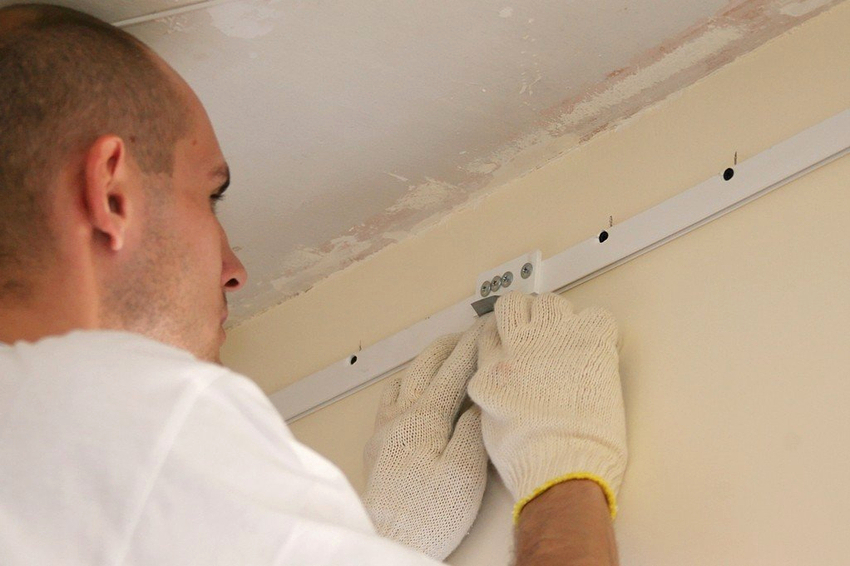
For installation of a stretch ceiling on plasterboard walls, sheets with a thickness of at least 1.2 cm are suitable
The additional mount is installed as follows:
- a frame of profiles is mounted in accordance with the standard technology for the construction of plasterboard walls;
- at the top, at the level of the ceiling, a mortgage is installed along the entire perimeter;
- the beam is fixed at the end of the supporting structure.
In order to make a do-it-yourself stretch ceiling on drywall walls, as required by the technology, it is necessary to use sheets of gypsum with a thickness of at least 1.2 cm.
Helpful advice! If the load on the plasterboard walls after installing the stretch ceiling is assumed to be insignificant, a thick guide profile can be used instead of a wooden beam.
How to remove a stretch ceiling with your own hands: a sequence of actions
The need to remove a stretch ceiling, provided that all preliminary work is completed, rarely arises. But situations when communication systems require changes or there is a desire to update the interior, still take place. Removing the ceiling, where the harpoon system was used as an attachment, is not difficult on your own. The procedure can be as follows:
- The decorative insert is removed to fill the gap between the wall and the ceiling. To do this, you need to explore the perimeter using stepladdersto find the junction.
- Preheat the film. When using a heat gun, it is convenient to immediately process the entire canvas. If a building hair dryer is used, it will be possible to reheat the parts that are supposed to be removed at a certain moment.
- In the corner, find the end of the harpoon soldering, which you need to grab with pliers and pull towards you. It is necessary to pull out the canvas carefully, applying uniform efforts so as not to damage the film.
After removal, the material must be placed on a clean, flat surface, especially if the stretch ceiling is white.
All of the above actions concerned PVC films. Fabric canvases, despite their strength, are much more difficult to dismantle. It is almost impossible to remove glazing beads without damaging the fabric on your own. And the masters do not always guarantee integrity. The lack of sufficient elasticity prevents the fabric from being re-installed.
How to install a stretch ceiling after repair
Reinstalling a stretch ceiling, provided that the canvas has retained its integrity, is not difficult. This is especially true for PVC films. If during the repair the position of the profiles has not changed, it remains only to perform the reverse steps to dismantling:
- The canvas must be hooked to the crocodile hangers in the four corners of the room.
- Heat the film with a heat gun.
- Using a spatula-spatula, bring the canvas into the corners in the profile, having previously removed it from the suspensions.
- Continue to insert the film into the profile, moving from the middle of each wall to the edges.
If you have an idea of how to make stretch ceilings with your own hands, installation after repair will not take much time.
It is more difficult to deal with a canvas on which there are patches. The cut area may burst when pulled. Therefore, you should be especially careful when filling the material in this part.
If the damage to the film is at a distance of no more than 10 cm from the profile, as a rule, the canvas must be cut to eliminate the defect. Installation after such a renovation seems simple in theory. In practice, it is not easy to stretch the area without wrinkling.
Important! The fabric should not be removed to eliminate defects. It is impossible to fasten it again in the profiles due to the lack of stocks, since after the initial installation all excess fabric is cut off.
How to stretch a stretch ceiling after flooding
Not a single stretch ceiling is insured against flooding, if there is any other living space above it. The reason is not always human.There are accidents that are simply impossible to prevent. After flooding, the canvas has a menacing appearance: a huge bubble forms in the center, which hangs over the furniture.
In fact, it is this design that is most resistant to the problem of flooding. You just need to know how the stretch ceiling is stretched after exposure to water. The best thing in such situations is to call specialists. But it is quite possible to cope on your own. It is necessary to act as follows:
- Turn off the electricity in the entire house or apartment.
- Prepare a hose and containers for drainage, cover furniture and objects that may be damaged by water ingress with foil.
- Remove the lamp, insert a hose into the hole and try to remove the liquid through it. If there are no fixtures, a small part of the ceiling needs to be dismantled so that the hose can be inserted. It is better to do this in one of the corners.
Then you need to figure out how to install the stretch ceiling with your own hands, that is, return it to its original position. First you need to dry the surface, leaving the hole for the lamp or the removed corner open. The canvas can self-repair after drying. If this does not happen, you will have to warm up the deformed areas, for which a household hairdryer is useful.
It is so easy to eliminate the consequences of the flood only if PVC films are used. Cloth canvases also hold liquid, but no more than 1-15 hours. The only drainage option for them is through the hole for the lamp, partial dismantling is unacceptable, so you should call specialists.
Installing a chandelier on a stretch ceiling with your own hands
All cables providing power supply to overhead lighting devices must be laid before installing the stretch ceiling. And not just cables. The place where the lamp will be fixed must also be prepared. To complete this task, you will need the following items:
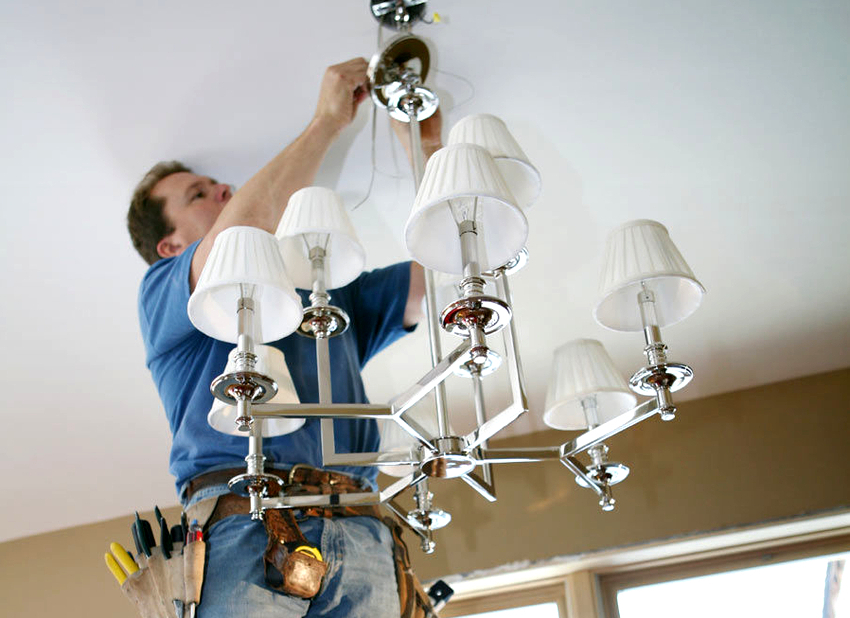
The place where the chandelier will be fixed must be prepared even before the installation of the canvas
- plastic platforms;
- pawns (holders, by means of which the mortgage will be attached to the ceiling base);
- rings.
The platforms are fixed with pawns at the location of the lamps. The lighting installation steps are performed after the structure has been tensioned. The center of the embedment is determined, a ring is glued to the outside of the canvas in this place.
Important! The centers of the platform and the ring must match, otherwise the luminaire will be installed crookedly or installation will not be possible at all.
After the glue dries, the fabric is cut in the ring. The place for the lamp is ready. Ring sizes are selected according to the type and size of the luminaire.
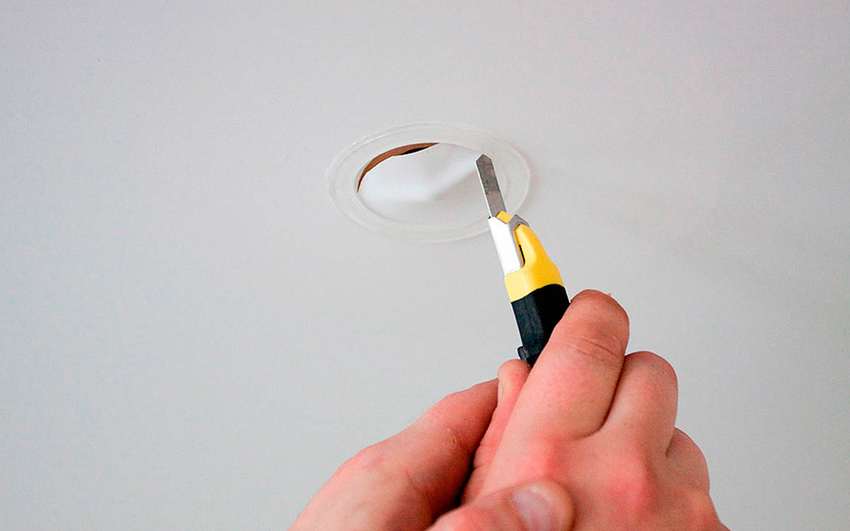
The dimensions of the ring for the canvas are selected in accordance with the size and type of the lamp
LED stretch ceilings are especially popular. In them, the lighting does not come from the central part, it is located along the perimeter of the room, behind the cornice or along the edge of the installed structure, if it is multi-level. It is the hidden position that creates the effect of soaring ceilings. An LED strip is used as lighting devices.
Features of installing a stretch ceiling in a room with a small height
The stretch ceiling can organically fit into any style of interior decoration. But there is a feature that prevents the installation of structures in low rooms: the mounted canvas is fixed at a certain distance from the base ceiling, therefore, it reduces the height of the room. And at the same time, there is no categorical “no”. You just need to think over and figure out how to make a stretch ceiling. The very fulfillment of such a task is also within the power.
Of all the technologies listed above, you need to choose exactly those methods that are suitable for specific conditions.You can recommend the following to owners of low rooms:
- purchase a medium-density canvas for installation (200-250 g /m²);
- choose a profile for a glazing bead (it steals height least of all);
- choose a light shade, as an option - a classic white, matte surface.
Then you can mount the structure. When deciding how to install a stretch ceiling with your own hands, the video below can be a good help. Here is the installation of a complex ceiling structure. Actions for the introduction of glazing beads can be seen quite clearly. The method of stretching the canvas is clearly visible, which is very important for high-quality installation.
Diy two-level stretch ceiling
I always want to make the interior of the hall expressive and festive. Stretch ceilings help to give this look to the design. Halls are usually larger than other living rooms, so multi-tiered ceilings can be installed in them. Since this article contains information containing tips for doing DIY installation, we will only talk about a two-level structure. More tiers are for professionals.
Installation can be done in two ways:
- create a drywall frame, attach baguettes to it and stretch the canvas;
- make a frame from a profile and install a stretch ceiling in it.
The second option is less expensive financially and in terms of time. In addition to the profile along the line for fixing the baguettes, according to the markings repeating the pattern of the ceiling, it is necessary to fix the wooden blocks. When creating curved shapes, a special profile with notches is used. For the installation of two-level ceilings, only a metal profile is recommended.
The technology of stretching the canvas is no different from the one-level structure used for installation.
Photos of stretch ceilings on the Internet show a lot of original options. This is a combination of matte and mirror surfaces, abstract elements and repeating concrete forms - flowers, leaves, geometric shapes.
Helpful advice! Two-level ceilings can be used for room zoning. The differentiation can be enhanced by installing different lighting in each tier.
DIY fabric ceilings: installation technology, video tutorials
A special place among tensioning structures is occupied by fabric canvases. Their disadvantages include the following characteristics:
- high cost in comparison with PVC film;
- limited choice;
- impossibility of re-installation on the previous frame.
But this type of canvas has a dignity, before which all the shortcomings recede - a presentable appearance. Installing a fabric stretch ceiling with your own hands without heating is not particularly difficult. The minimum set of tools is required:
- laser level;
- roulette;
- puncher;
- screwdriver;
- scissors;
- scapula.
Measurements are taken with a tape measure, the canvas is cut off with scissors. It should be 15-20 cm larger on each side. It is worth noting that its maximum width is 500 cm, so almost no welding or joining is required. The profile fixation line is marked with a laser. It is attached to the walls using a puncher and a screwdriver.
The fabric is tucked into the profile with a special spatula, initially fixed with glazing beads (bead installation method) in the middle of each side, then from the center to the corners. After threading and fastening, the excess fabric is trimmed.
Video tutorials will help prevent mistakes when installing such stretch ceilings with your own hands:
DIY stretch ceiling: step by step instructions
This article contains a large amount of information on how stretch ceilings of different types are installed, what tools are used for this, methods of fastening, etc. But even with the difference in many indicators and characteristics, the algorithm of actions is practically the same.
Next, step-by-step instructions (generalized version) will be offered, which reflects the main stages in the desired sequence:
- Preparation of the premises for the installation of the stretch ceiling: removal of furniture, inspection (and, if necessary, leveling) the walls, elimination of ceiling defects.
- Placing the necessary tools and devices in accessible places.
- Taking measurements, drawing markings on the walls and, if necessary, on the ceiling.
- Fixing profiles.
- Registration of places for the installation of lighting devices.
- Preparation of the canvas (placement, heating).
- Fixing material in profiles.
- Hanging lamps.
- Sealing the gap between the walls and the ceiling.
When installing stretch ceilings with your own hands, step-by-step instructions are the starting point that will not allow you to miss any of the stages, will help you prepare well for each type of action.
Helpful advice! Before taking on the independent installation of the tensioning structure, you need to have an idea of the process as a whole.
Do-it-yourself stretch ceiling installation: video
There are many videos posted on the Internet that demonstrate the process of installing a stretch ceiling. Some videos were shot by professionals, others by amateurs. In the second case, inaccuracies and even errors are quite acceptable. Is it possible to figure out and determine whether it is worth taking what he saw on faith, consider it the answer to the question of how to stretch a stretch ceiling with your own hands?
Here it will be useful to use some tips:
- watching the videos is only after mastering the relevant theoretical information;
- if after performing the actions the intermediate result is not shown - there is no reason to take what you saw seriously;
- in a situation where after viewing there are a lot of questions, you should also not trust the author.
In fact, the reflection in the video of the installation of the stretch ceiling with your own hands step by step will be the basis for considering the video meaningful, and the actions you see - verified and professional. Particular attention should be paid to videos that demonstrate and comment on the use of tools. This is a very important question, since inept use will complicate the work and can lead to extremely undesirable results.
How much is the installation of a stretch ceiling, the price of the canvas
Stretch ceilings, like many other products, have different prices. It is due to the quality of the material, wrap, manufacturer, region where it is sold, and many other reasons. The total cost of the structure also depends on who installed the stretch ceiling. If you do it yourself, you save almost half of the costs.
The cheapest canvas is PVC film. Its starting price is 120 rubles for 1 m²... It is a thin material with a minimum allowable density of 180 g /m²... For denser options, the price reaches 670 rubles per 1 m²... The fabric, although it is also synthetic, has a more complex manufacturing technology and, accordingly, a price. The cheapest fabric for the ceiling costs 350 rubles for 1 m², and expensive options - 1500 rubles per 1 mm².
To save money, it is better to purchase material and order installation in one organization. The minimum price of stretch ceilings for 1 m² with installation - 300 rubles. Separately, the installation of a structure with a canvas of average cost will be 400 rubles per 1 mm².
Helpful advice! It is better to invite specialists from officially operating companies to install a stretch ceiling, since they give a guarantee for the structure. Otherwise, if cracks appear on the canvas after poor-quality installation (which often happens), no one will compensate for the damage.
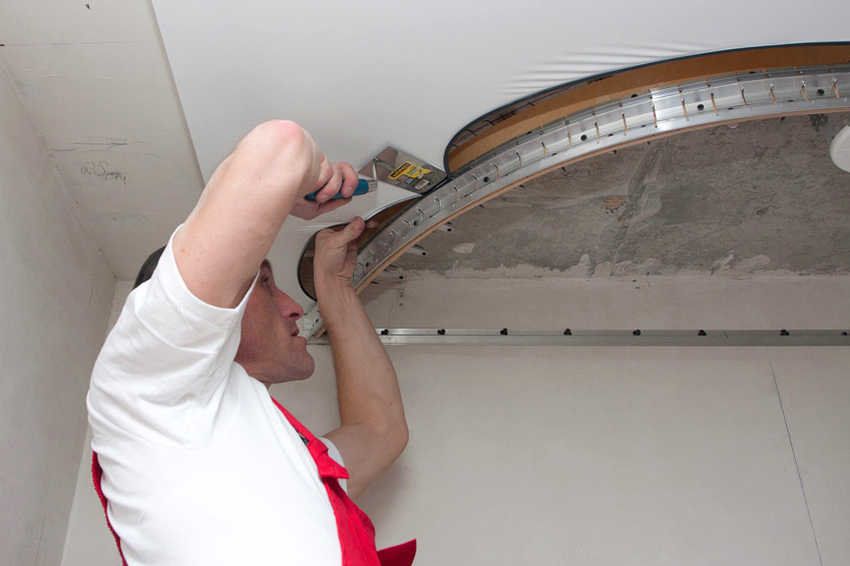
To install a stretch ceiling, it is better to invite specialists from officially operating companies
DIY stretch ceilings: material and interior
In this section, I would like to draw your attention to the decorative side of stretch ceilings. To avoid busting, you need to plan the interior design in the aggregate of all its elements, where, first of all, you should take into account the compliance with the style. Each style direction is characterized by certain colors and shades. White will organically complement the classic interior, it is appropriate in ethno and boho-chic styles. For avant-garde and art deco, pale tones, matte surfaces of the material are unacceptable. Stretch ceiling in Art Deco can have intricate shapes, gilded frames.
But for country (rustic style) a white ceiling will be very useful, but not a glossy or matte film, but a fabric one. It will emphasize and make more expressive stylized interior elements. The textiles will acquire new colors to revitalize the room.
Disharmony of colors, fake luxury, evocative forms - kitsch, the style of extraordinary creative natures. Is there a place for ceiling paintings in such an interior? With a certain approach, yes. It is necessary to do a stretch ceiling kit with your own hands, that is, to make a structure of several fragments, each of which will shine in different ways, creating a flurry of intense light.
A stretch fabric in the hands of a skilled designer is an indispensable tool for decorating a unique interior.
Helpful advice! When planning to assemble a complex stretch ceiling structure with your own hands, consisting of canvases located at different levels and divided into fragments, it is worth discussing the technical side of the installation with specialists. Without experience, it will be extremely difficult to complete such a task without errors and miscalculations.
Do-it-yourself stretch ceiling: reviews, opinions
The experience of others is never superfluous. In general, the feedback on self-installation is positive, many are satisfied with the savings, because this part is the most expensive. A large number of posts ends with approximately the following advice: purchase a stretch ceiling kit, mount it yourself (reviews of many users confirm this) and enjoy the aesthetics of the structure. But there are also opinions that self-installation of a stretch ceiling is extremely difficult. And these reviews are reasoned enough.
“… The first day ended with the fact that I dropped everything. And this is just the profiles I exhibited. I have a water level, accurate, but in the end the planks did not fit, I redid it three times. It was troublesome, I wasted two days, and the waves remained in one corner. Not two, but three of us need to work ... "
Evgeny, Chelyabinsk
“A friend convinced him, he pulled the film himself. They took the cannon, took about thirty minutes to understand and adapted how it works. On the Internet, we looked at what and to what temperature to heat it, brought thermometers, then realized that the outlet temperature needed to be controlled. Dexterously, as in rollers, it did not work out, they pulled, heated and leveled for four hours, maybe longer. It seems to have worked out, my wife likes it, but I won't take it anymore, I'd rather pay. "
Svyatoslav, Lipetsk
“This is the second ceiling, the first was made of fabric, installed in the nursery. The room was small, 11 squares, somehow it turned out easy. There was no need to warm up anything. And they took a glossy canvas into the hall to shine, to be festive.They fiddled for a long time, in one place near the edge they torn with a spatula, tightened. Finally finished! It is difficult to mount 6 squares, they were held and fed with a mop. This business is for specialists who do not know - I do not advise taking it. And I do not recommend a glossy ceiling. We walk like in a mirror, annoying. "
Artem, Noyabrsk
“… I immediately realized that it was difficult. But I thought that others put it themselves. I could not find in the videos how to lift the canvas correctly. My son and I, as they say, danced. They heated it for a long time: we have a building hair dryer, its air flow is narrow. The second time I will already know what to do. But in the first one you need to call someone who previously installed ... "
Vsevolod, Shakhty
Of course, everyone has their own understanding of skill, skills, etc. Surely there are those who really should not take on the independent installation of a stretch ceiling.
It is possible to make the room cozy and the interior refined without attracting significant funds. Your own taste and creative imagination will allow you to create a unique design of the ceiling, and this article will tell you the ways and ways to bring original ideas to life.

